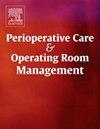哈马丹医院腰痛维度的横断面研究
IF 1
Q2 Nursing
Perioperative Care and Operating Room Management
Pub Date : 2025-01-06
DOI:10.1016/j.pcorm.2025.100464
引用次数: 0
摘要
背景:腰痛(LBP)是最常见的肌肉骨骼疾病,被认为是世界上最使人衰弱的慢性疾病之一。由于工作环境的不同,手术室人员发生腰痛的风险较高。因此,本研究的目的是调查哈马丹医院手术室人员腰痛的患病率、维度和危险因素。方法对哈马丹医科大学附属教学医院2023年的350名手术室人员进行描述性横断面调查。样本量采用普查法估计。数据分析采用SPSS ver中的描述性统计、频率分布、均值和标准差、卡方检验、t检验和方差分析。22.结果78.3%的患者有腰痛。在所研究的手术室中,上颌面手术室和整形重建手术室的LBP发生率最高,最低。最常见的LBP包括急性LBP(40.6%)和区域性疼痛,其中疼痛没有辐射到腿部。在这项研究中,大多数腰痛患者主诉有尖锐疼痛(28.3%)和轻微的短暂性疼痛,无需止痛药或休息即可消退结果还揭示了年龄、工作年限和医院类型与腰痛患病率之间的显著关系。结论:本研究结果显示,手术人员腰痛的患病率很高,不幸的是,这些人中的许多人在工作的头几年就出现了这种情况。因此,建议手术室人员定期筛查和评估肌肉骨骼疾病(MSDs)和腰痛,并向他们提供有关这一并发症的充分信息。本文章由计算机程序翻译,如有差异,请以英文原文为准。
A cross-sectional study on dimensions of low back pain in Hamedan Hospitals
Background
Low-back pain (LBP) is the most common musculoskeletal disorder, which is considered one of the most debilitating chronic conditions worldwide. The operating room personnel are at higher risk of LBP due to the different working environment. Therefore, the aim of present study was to investigate the prevalence, dimensions and risk factors of LBP among operating room personnel of Hamedan hospitals.
Methods
This descriptive-cross-sectional study was conducted on 350 operating room personnel of teaching hospitals affiliated to Hamedan University of Medical Sciences in 2023. The sample size was estimated by census method. Data analysis was also carried out using descriptive statistics, frequency distribution, mean and standard deviation, chi-square test, t-test and ANOVA in SPSS ver. 22.
Results
Most of the participants (78.3 %) had LBP. Among the studied operating rooms, the highest and the lowest LBP rate belonged to the maxillofacial operating room and the plastic and reconstructive surgery operating rooms, respectively. The most prevalent LBP included acute LBP (40.6 %) and the regional type in which the pain did not radiate into the legs. Most people with LBP in this study complained of sharp pain (28.3 %) and mild transient pain that subsided without painkillers or rest.29 The results also revealed a significant relationship between age, years of work experience and type of hospital with LBP prevalence.
Conclusions
The results of the present study showed high prevalence for LBP among operating room personnel, and unfortunately, many of these people develop this condition within the first few years of their work. Therefore, it is recommended that operating room personnel are regularly screened and evaluated for musculoskeletal disorders (MSDs) and LBP, and adequate information about this complication is given to them.
求助全文
通过发布文献求助,成功后即可免费获取论文全文。
去求助
来源期刊

Perioperative Care and Operating Room Management
Nursing-Medical and Surgical Nursing
CiteScore
1.30
自引率
0.00%
发文量
52
审稿时长
56 days
期刊介绍:
The objective of this new online journal is to serve as a multidisciplinary, peer-reviewed source of information related to the administrative, economic, operational, safety, and quality aspects of the ambulatory and in-patient operating room and interventional procedural processes. The journal will provide high-quality information and research findings on operational and system-based approaches to ensure safe, coordinated, and high-value periprocedural care. With the current focus on value in health care it is essential that there is a venue for researchers to publish articles on quality improvement process initiatives, process flow modeling, information management, efficient design, cost improvement, use of novel technologies, and management.
 求助内容:
求助内容: 应助结果提醒方式:
应助结果提醒方式:


